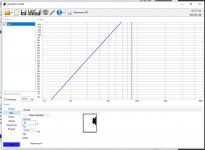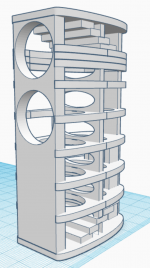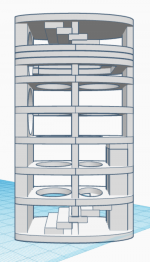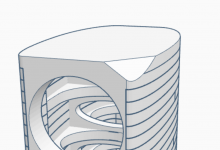So then as I already knew the curved walls should already prevent a big part of the standing waves. Really the only thing to be dealt with is the vertical standing wave in the height of the enclosure. If standing waves are (mostly) caused by parallel surfaces, won't it just be possible to prevent the vertical standing wave by making the internal bottom and/or top wall slanted? This would be fairly easy to implement, let alone compared to splitting the cabinet in two without creating more parallel surfaces.
I am and will be handling time alignment in the DSP. As I said before, the bass, midrange and tweeter modules are separated purely for vibration decoupling and being able to swap drivers without having to rebuild the entire cabinets would I want to switch for example to the beryllium Illuminator in the future. They are not for time alignment.
Why should the Qtc be 0,707 or lower? Then the woofers will reach Xmax rather quickly. And it doesn't make that much of a difference in impulse response. In fact, in a smaller enclosure, the the first recoil is shorter though at the cost of a tiny bit more stretched out wobbling after that.
@40 W:
Perhaps I'm seeing this wrong, but in post #19 it looks like the tweeter enclosure has a smaller footprint than the other drivers. You should try making them the same. You'll have less diffraction from other enclosure parts then.
A critically damped system (Qtc =0.707) has, in my opinion, the best balance between bass extension in a sealed cabinet and step response. At 0.707 you won't have ANY ringing, just a bit overshoot. At Qtc=0.5 you don't even have overshoot anymore. It does require huge boxes though.
The Qtc you entered (Qtc of 0.756) isn't that much higher, but it's a design choice. I didn't calculate the numbers, but based on your simulations it saves 20L compared to qtc = 0.707. I can understand the choice then🙂
What's overschoot?
I'm not trying to save space. There's more than enough space available in the cabinets.
I'm not trying to save space. There's more than enough space available in the cabinets.
So then as I already knew the curved walls should already prevent a big part of the standing waves. Really the only thing to be dealt with is the vertical standing wave in the height of the enclosure.
Well, the sides do not have a strong curve, there could be a cross-standing wave. That isn't a problem though because at that frequency you can easily eliminate it with heavy acoustic foam on the walls and I think your bass will be crossed over below that frequency anyway. That's something I would not break a sweat at all.
If standing waves are (mostly) caused by parallel surfaces, won't it just be possible to prevent the vertical standing wave by making the internal bottom and/or top wall slanted? This would be fairly easy to implement, let alone compared to splitting the cabinet in two without creating more parallel surfaces.
You can ofcourse do that. If it's easy to do it at the bottom and top, it's exactly as easy in the middle too.
Why should the Qtc be 0,707 or lower? Then the woofers will reach Xmax rather quickly.
With a Qtc of 0,7 and lower you'll get a much slower drop towards the lower frequencies. The low end will often fits very well to the room gain and the lower frequency range is greatly extended. A Qtc of 0,7 provides the most linear response with a very good impulse answer. A Qtc 0f 0,5 provides by far the best impulse answer but is often avoided because the enclosure can quickly reach overdimensioned enclosure volumes. For a mid driver a Qtc of 0,5 is deemed ideal btw.
And it doesn't make that much of a difference in impulse response. In fact, in a smaller enclosure, the the first recoil is shorter though at the cost of a tiny bit more stretched out wobbling after that.
Uhm, that's wrong, all of it. With a smaller enclosure you'll get a HIGHER Qtc (not lower), a bump in the response and a steeper drop off at the low end and a low frequency drop at a higher frequency. And that 'tiny bit more stretched out wobbling' 🙄 is exactly the difference of a clear, precise, differentiated and detailed bass and the sound of some Amazon/online retailer speaker bass. If you don't care about that then you should order some 30-40€ drivers (which aren't that bad) and save a ton of money. The Qtc determines how the speaker will sound. And no, you can't 'fix' that with some simple EQing because that's a long decay delay of the mechanical part of the speaker.
Last edited:
I've got a little over 80 L available in the enclosures. That should enable a lower qtc. Though then the woofers will reach xmax quicker.
The reason a curved wall is stiffer is because you are forcing a flat piece of material into a curve.
No, it does not require forcing the flat material. Curved wall is stiffer anyway, because of the shape.
Stack Plywood sections instead. A single mistake with the MDF stack and its toast as MDF will shatter.
The ply can be screwed and glued quickly and then sanded smooth. that way you can line them up by eye. A nail gun with glue is easier.
The ply can be screwed and glued quickly and then sanded smooth. that way you can line them up by eye. A nail gun with glue is easier.
Really the only thing to be dealt with is the vertical standing wave in the height of the enclosure.
sealed it will be a half-wave resonance, but you could also consider taking advantage of it by making it an ML-TL.
dave
With a Qtc of 0,7 and lower you'll get a much slower drop towards the lower frequencies. The low end will often fits very well to the room gain and the lower frequency range is greatly extended
+1
dave
Stack Plywood sections instead.
I hadn’t got to that. As far as i’m concerned MDF is not a suitable material for building loudspeakers.
dave
Is it actually really necessary to really cut the volume in pieces to reduce standing waves? Can't it just be done with a big diffuser?
You are aware the diffusor takes up a lot of enclosure volume?
Why should the Qtc be 0,707 or lower? Then the woofers will reach Xmax rather quickly.
Look at your own simulations.
At 58l (Qt=0,7?) the maximum excursion is exceeded at ~29Hz.
At 72l (Qt=0,5?) the maximum excursion is exceeded at ~27Hz.
I don't know if that's still the case but last time I checked, 27Hz was lower than 29Hz. 😉 So, in theory it's a tiny bit better. Below that, yes, you get more excursion but also more spl, that's mostly irrelevant though, if you want to play that low, use simply bigger drivers. I've used the SS 21W (too lazy to type in the tsp, sry) for a max spl simulation, in 35 and 60l. Practically the same. Your driver will perform the same, maybe with a bit offset but the graph will not have a bigger difference either. Ignore the top right numbers, that was the different cursor position, the Qt and size are left bottom.
Attachments
Perhaps I'm seeing this wrong, but in post #19 it looks like the tweeter enclosure has a smaller footprint than the other drivers. You should try making them the same. You'll have less diffraction from other enclosure parts then.
A critically damped system (Qtc =0.707) has, in my opinion, the best balance between bass extension in a sealed cabinet and step response. At 0.707 you won't have ANY ringing, just a bit overshoot. At Qtc=0.5 you don't even have overshoot anymore. It does require huge boxes though.
The Qtc you entered (Qtc of 0.756) isn't that much higher, but it's a design choice. I didn't calculate the numbers, but based on your simulations it saves 20L compared to qtc = 0.707. I can understand the choice then🙂
I thought I should make the flat baffle as shallow as possible and the radius of the roundings as big as possible to get the best diffraction results so yes the tweeter and midrange are smaller. Though you do get small edges from the wider woofer and midrange boxes. But when I make all the baffles as wide as the woofer box they will be quite wide and the roundings quite small for the midrange and tweeters, making the corners still quite sharp.
In my simulation the qtc is 0,707 in 72 L. About 0,752 in 58 L. In simulation the F3 stays exactly the same though yes it rolls off slower in 72 L. Excursion wise in 72 L it reaches Xmax at 22 Hz at 30 watts. In 58 L the excursion rises faster though after it has made the biggest leap up, it stays flat so yes it reaches Xmax higher at 28 Hz though at 40 watts instead of 30.
But I think I will go with the 72 L after all. You say room integration and the quality and tightness of the bass is actually better in 72 L, which I believe and can understand since the woofer performs the most linear at qtc = 0,707. Yes it won't be able to handle as much power but 40 watts instead of 30 offers less than just one and a half dB extra SPL. And anyway, 107,4 dB in simulation + room gain in my tiny room will be more than loud enough.
But I think I will go with the 72 L after all. You say room integration and the quality and tightness of the bass is actually better in 72 L, which I believe and can understand since the woofer performs the most linear at qtc = 0,707. Yes it won't be able to handle as much power but 40 watts instead of 30 offers less than just one and a half dB extra SPL. And anyway, 107,4 dB in simulation + room gain in my tiny room will be more than loud enough.
Both enclosure sizes are working fine, 0,7 isn't bad either. If a box would become too big, you can go to a higher Qt but I wouldn't do that if not necessary. To make the volume smaller is never a problem, extending it however, is. If you want more punch, you can EQ it a bit anytime anyway.
So then as I already knew the curved walls should already prevent a big part of the standing waves.
@40 W:
They will not. They will only change the modes of the standing waves. if curved improperly, they can actually reinforce standing wave modes, depending on how reflections occur.
Well uhhhh, then I don't know what to do anymore either. For this particular design for something in these dimensions without making it too complicated or ugly I think it doesn't get a whole lot better than this in terms of avoiding standing waves. Of course the damping material will also take care of most of the problems.
About the different widths of the woofer, midrange and tweeter boxes and the different diameter roundings. Won't this be a great option? Cutting of a triangle along the entire edge where the woofer and midrange boxes are wider than the tweeter box. This should solve the problem of diffraction on those flat surfaces but I can keep the midrange and especially tweeter boxes nice and slim with large diameter roundings.
Troels Gravessen did something similar with the baffles of his Jenzen speakers. Though they also had stepped baffles.
About the different widths of the woofer, midrange and tweeter boxes and the different diameter roundings. Won't this be a great option? Cutting of a triangle along the entire edge where the woofer and midrange boxes are wider than the tweeter box. This should solve the problem of diffraction on those flat surfaces but I can keep the midrange and especially tweeter boxes nice and slim with large diameter roundings.
Troels Gravessen did something similar with the baffles of his Jenzen speakers. Though they also had stepped baffles.
Attachments
Last edited:
Part of the appeal of slim cabinets was as a diffraction mitigation strategy while retaining a square box. Substantial rounding can be a superior strategy, making the 'slim' factor optional.tweeter boxes nice and slim with large diameter roundings.
They will not. They will only change the modes of the standing waves. if curved improperly, they can actually reinforce standing wave modes, depending on how reflections occur.
So when somebody does not want standing waves to be reinforced, they should make just a straight sided box where there are no curves? So basically ball shape enclosures and speakers like B&W Nautilus would be the worst designs because there are so many curves?
Last edited:
Yes it won't be able to handle as much power but 40 watts instead of 30 offers less than just one and a half dB extra SPL.
Actually not. Max SPL at a given frequency, say 30Hz, depends only on cone area and Xmax, not on the wattage you need to reach the Xmax (closed box).
- Status
- Not open for further replies.
- Home
- Loudspeakers
- Multi-Way
- Redesigning my cabinets. Thoughts?




